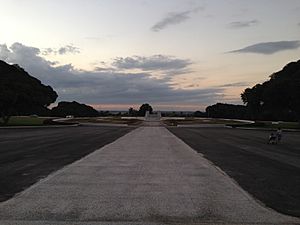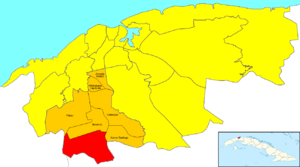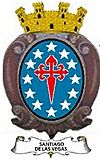Santiago de las Vegas facts for kids
Quick facts for kids
Santiago de las Vegas
|
||
|---|---|---|

El Cacahual Monument
|
||
|
||

Location of Santiago de las Vegas (red)
within Boyeros (orange) and Havana |
||
| Country | ||
| Province | ||
| Municipal borough | Boyeros | |
| Founded | 1683 | |
| Established | 1725 (town) | |
| 1824 (city) | ||
| Elevation | 90 m (300 ft) | |
| Population
(2021)
|
||
| • Total | 30,844 | |
| Time zone | UTC-5 (EST) | |
| Area code(s) | +53-7 | |
Santiago de las Vegas is a part of Boyeros, which is a larger area (a municipality) within Havana, Cuba. It is located about 20 kilometers (12 miles) south of Havana's main city center. In 2021, about 30,844 people lived there. The Cuban government has an important farm research center and a weather station in the city.
Contents
History of Santiago de las Vegas
Early Beginnings: Tobacco Farms
The first people settled here in 1683. They were tobacco farmers who started growing crops on lands known as Sócalo Hondo, Managua, Bejucal, and La Chorrera. At that time, these lands were managed by the Roman Catholic Archdiocese of Santiago de Compostela.
The number of people living in the area grew quickly. By 1694, the first church was built to serve the growing community.
Becoming a Town and City
On June 18, 1725, Santiago de las Vegas officially became a town. It was given the name Santiago de Compostela de las Vegas by a special royal document. This document also gave the town a large area of land and power to govern itself. This made Santiago de las Vegas more important politically and economically.
In 1824, the town was declared a city. This was a big step! The people were even allowed to put up a statue of the Spanish King Ferdinand VII in Recreo Square. In return, in 1831, the king gave the city a special title: "Faithful and Very Illustrious City Council."
Changes and Growth
In 1836, the city was supposed to get its own government land ownership. However, in 1840, this was given to Bejucal instead. But don't worry, Santiago de las Vegas got it back in 1845.
The city's church was finished in 1800. Sadly, one of its towers was damaged by a hurricane in 1846. A cemetery was built in 1814, but it was closed in 1895 when a new one was opened. In 1911, the "Consistorial House," which was a government building, was constructed.
The population of Santiago de las Vegas continued to grow steadily. It went from about 3,300 people in 1861 to nearly 11,000 people by 1953.
Modern Changes
In 1976, Santiago de las Vegas lost its status as a separate municipality. This happened because the government of Fidel Castro created a new way of dividing up the country. Now, Santiago de las Vegas is part of the new municipality of Boyeros. This means it is now part of the larger Havana city area.
On May 18, 2018, a sad event occurred when Cubana de Aviación Flight 972 crashed in the area, resulting in the loss of 112 lives.
Transportation and Important People
A Hub for Travel
Transportation is a very important industry for Santiago de las Vegas. The city is located between the busy city areas of Cuba and the countryside to the south. This makes it a key spot for many people traveling between these two regions. Its bus station was once a main branch of the National Bus Station in Havana.
Famous People from Santiago de las Vegas
Many notable people were born in Santiago de las Vegas:
- Italo Calvino: A famous Italian writer, born here in 1923.
- Juan Tomás Roig Mesa: A well-known scientist and botanist. He was famous for his work on medicinal and poisonous plants.
- Helio Orovio: An ethnomusicologist, someone who studies music from different cultures.
- Esther Borja: A talented mezzo-soprano, a type of singer.
Special Care Facilities
Santiago de las Vegas is also home to three important care facilities in Cuba:
- The Psychiatric Hospital of Mazorra, which helps people with mental health needs.
- The "Los Cocos" sanatorium, which provides housing and care for people living with HIV/AIDS.
- The Sanatorium of El Rincón, which cares for patients with leprosy.
Having these facilities means there are also more places to stay and eat in the community for visitors and families.
Tourism and Celebrations
Airport and Opportunities
The building of the José Martí International Airport in Havana has brought many chances for tourism to grow in Santiago de las Vegas. The city has interesting natural places, historical sites, cultural spots, and religious attractions. These opportunities have helped create new ways for the city to earn money, leading to new hotels, restaurants, and jobs.
The San Lázaro Celebration
One of the biggest religious celebrations in Cuba is the festival of San Lázaro, held every year on December 17. In the days leading up to it, tens of thousands of devoted people, visitors, and curious onlookers gather. They make a pilgrimage (a special journey) to the shrine of El Rincón. Some people wear special clothes or carry unique items as a way to show thanks to the amazing San Lázaro. He is also connected to the Yoruba deity known as Babalu Aye.
See also
 In Spanish: Santiago de las Vegas para niños
In Spanish: Santiago de las Vegas para niños



